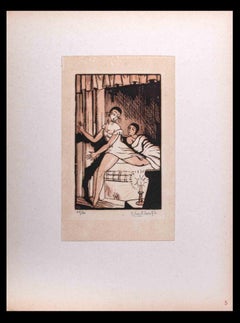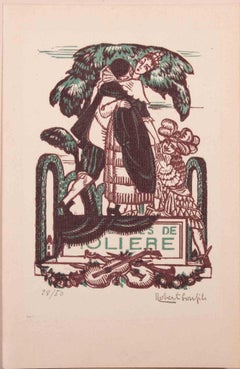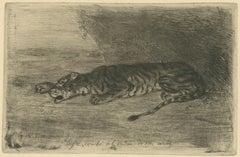Robert Bonfils Figurative Prints
French, 1886-1972
Born in Paris, Bonfils spent 1903-1909 at various Parisian art schools: the École Germain Pilon, the École Nationale Supérieure des Arts Décoratifs (where he subsequently taught for thirty-two years), and the École des Beaux Arts. From 1909 he exhibited regularly at the Salon d'Automne, by 1912 he was exhibiting at Salon des Artistes Décorateurs and then subsequently at Tuileries and abroad.
He was an organiser of the 1925 Paris International Exposition of Modern Industrial and Decorative Arts, and the 1937 Exposition.
His relationship with Bianchini who produced many of his textile designs commenced in 1915. He was made Chevalier de la Légion d'honneur in 1926, being promoted to Officier in 1938.to
3
Overall Width
to
Overall Height
to
2
14
846
382
379
308
3
1
2
1
3
3
1
1
1
1
1
1
2
1
1
2
1
Artist: Robert Bonfils
Lovers - Woodcut Print on Paper By Robert Bonfils - Mid 20th Century
By Robert Bonfils
Located in Roma, IT
Lovers is an original artwork realized by Robert Bonfils (1886-1972). Original woodcut print on paper, realized on early-20th century, hand signed in pencil by the artist on the lowe...
Category
Mid-20th Century Modern Robert Bonfils Figurative Prints
Materials
Woodcut
Robert Bonfils French Market
By Robert Bonfils
Located in San Francisco, CA
Robert Bonfils: 1886-1972. Well listed French artist with auction results for posters and prints over $8000. This fabulously busy etching measures 12 1/2 inches wide by 9 high. It is...
Category
1950s Realist Robert Bonfils Figurative Prints
Materials
Etching
Amoureux de Molière - Woodcut Print By Robert Bonfils - Mid 20th Century
By Robert Bonfils
Located in Roma, IT
Amoureux de Molière is an original artwork realized by Robert Bonfils (1886-1972). Original woodcut print on paper, realized on early-20th century, hand signed in pencil by the artis...
Category
Mid-20th Century Modern Robert Bonfils Figurative Prints
Materials
Woodcut
Related Items
Wedding Party
Located in Buffalo, NY
An original mid century modern woodblock print.
This work is hand signed illegibly and titled "Wedding Party".
Category
1960s Modern Robert Bonfils Figurative Prints
Materials
Paper, Woodcut
Tigre couché à l'entrée de son antre (Tiger Lying at the Entrance to its Lair)
By Eugène Delacroix
Located in Middletown, NY
Etching, drypoint, and roulette on watermarked Hallines cream laid paper, 3 3/4 x 5 7/8 inches (95 x 148 mm), full margins. A very good impression of this charming image, with all of...
Category
Early 19th Century Realist Robert Bonfils Figurative Prints
Materials
Laid Paper, Drypoint, Etching
Peace
By Anton Refregier
Located in Fairlawn, OH
Peace
Woodcut printed in orange red ink on japanese paper
Signed and titled in pencil lower right (see photo)
Titled lower left (see photo)
Created along with an illustrated book project Song of Peace, 1950-1959.
Condition: Excellent
Image: 10 1/2 x 4 7/8"
Sheet: 16 1/8 x 7";
Anton Refregier (March 20, 1905 – October 10, 1979) was a painter and muralist active in Works Progress Administration Federal Art Project commissions, and in teaching art. He was a Russian immigrant to the United States.
Among his best-known works is his mural series The History of San Francisco, located in the Rincon Center in downtown San Francisco, California. It depicts the city's history across twenty seven panels that he painted from 1940 to 1948.
Life and early career
Refregier was born in Moscow and emigrated to the United States in 1920. After working various odd jobs in New York City, he earned a scholarship to the Rhode Island School of Design in 1921. After finishing school, Refregier moved back to New York in 1925. To earn a living, Refregier worked for interior decorators, creating replicas of François Boucher and Jean-Honoré Fragonard paintings...
Category
1950s American Modern Robert Bonfils Figurative Prints
Materials
Woodcut
Dan Burne Jones, Affection
Located in New York, NY
Dan Burne Jones is widely know as the author of the Rockwell Kent print catalogue raisonne. It's so interesting to see that he is a gifted wood engraver as well. Jones's own prints a...
Category
1930s American Modern Robert Bonfils Figurative Prints
Materials
Woodcut
Canoe - Peter Doig, Contemporary, 21st Century, Etching, Magic Realism, Edition
By Peter Doig
Located in Zug, CH
Canoe - Peter Doig, Contemporary, 21st Century, Etching, Magic Realism, Limited Edition
Edition of 500
Signed and numbered, accompanied by Certificate of Authenticity
In mint conditi...
Category
Early 2000s Realist Robert Bonfils Figurative Prints
Materials
Etching
$2,441 Sale Price
68% Off
H 23.43 in W 29.53 in
Le Chat et Les Fleurs
By Édouard Manet
Located in Middletown, NY
Etching and aquatint on cream laid, watermarked Rives paper. 6 5/8 x 5 inches (167 x 126 mm). Sixth and final state, a posthumous impression. A fine, inky impression with full margin...
Category
1860s Realist Robert Bonfils Figurative Prints
Materials
Aquatint, Etching
Agony - The architecture of decay -
Located in Berlin, DE
Jörg Olberg (*1956 Dresden), Agony, 1987. etching, E.A. (edition of 30), 24 x 17 cm (image), 46 x 37 cm (sheet), each signed in pencil lower right "Olberg" and dated "IX [19]87", inscribed lower left "E.A. [Epreuve d'Artiste]".
- minimal crease and dust stains in the broad margin
- The architecture of decay -
About the artwork
Jörg Olberg draws here the sum of his artistic study of the Berlin ruins, which were still present in the cityscape well into the 80s. With his work "Agony" he creates an allegory of decay. Positioned in the landscape of ruins, a ruined house grows before the viewer, rising like the Tower of Babel into the sky, its roof and gable brightly illuminated by the sun. But already the roof shows mostly only the rafters, and as the gaze is drawn further down, the building visibly disintegrates, the beams protruding in all directions looking like splintered bones. Slowly but inexorably - in agony - the house will collapse in on itself and become nothing more than the burial mound of itself. At the same time, the small-scale stone composition and the plaster form a pattern-like ornamentation of decay.
The tension in the picture is fed by the counter-movement of growth and collapse, which is heightened by the dramatic formation of clouds. The swirls of clouds are reminiscent of a world landscape...
Category
1980s Realist Robert Bonfils Figurative Prints
Materials
Etching, Paper
$262 Sale Price
20% Off
H 18.12 in W 14.57 in D 0.4 in
By Night On My Bed
Located in New York, NY
Woodcut. Signed by the artist and dated in pencil, lower right. Titled in pencil, lower left, and numbered "28" in pencil, lower center.
This woodcut was made by Esherick to ill...
Category
1920s American Modern Robert Bonfils Figurative Prints
Materials
Woodcut
Harvest #2
By Walter Williams
Located in New York, NY
Color woodcut. Signed by the artist in pencil, lower right. Titled "Harvest 2" in pencil, lower center. Numbered "2nd 5/12 Special Edition" in pencil, lower left.
Framed dimensi...
Category
1960s Modern Robert Bonfils Figurative Prints
Materials
Woodcut, Color
Young Lady in Yellow Dress
By Ernest Crichlow
Located in New York, NY
Color etching and aquatint on wove paper. Signed, titled and numbered 56/100 in pencil.
This etching is made after the painting of the same subject "Woman in Yellow Dress...
Category
1970s Realist Robert Bonfils Figurative Prints
Materials
Color, Etching, Aquatint
Winter on Cruise
By Jim Dine
Located in New York, NY
A very good impression of this color woodcut and lithograph diptych. Signed and dated in pencil by Dine. From a limited edition of 12.
Category
Early 2000s Modern Robert Bonfils Figurative Prints
Materials
Color, Lithograph, Woodcut
Stevan Dohanos, Backyard
By Stevan Dohanos
Located in New York, NY
Stevan Dohanos was an accomplished draftsman who work was widely known through the Saturday Evening Post. This print 'Backyard,' however, leaves aside the illustrative magazine work ...
Category
1930s American Modern Robert Bonfils Figurative Prints
Materials
Woodcut
Robert Bonfils figurative prints for sale on 1stDibs.
Find a wide variety of authentic Robert Bonfils figurative prints available for sale on 1stDibs. You can also browse by medium to find art by Robert Bonfils in woodcut print, etching and more. Much of the original work by this artist or collective was created during the 20th century and is mostly associated with the modern style. Not every interior allows for large Robert Bonfils figurative prints, so small editions measuring 5 inches across are available. Customers who are interested in this artist might also find the work of Bernard Brussel-Smith, François Desnoyer, and Pierre-Paul Jouve. Robert Bonfils figurative prints prices can differ depending upon medium, time period and other attributes. On 1stDibs, the price for these items starts at $251 and tops out at $850, while the average work can sell for $251.


